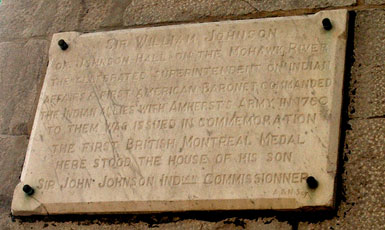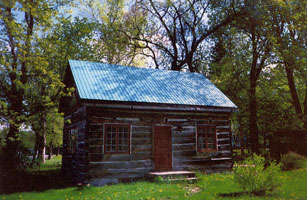 |
Old stone tablet on the east wall of the Bonsecours Market Building facing
la rue Bonsecours in Vieux-Montreal. Photo by Robert Wilkins UE
The Constitutional Act of 1791 divided the
old Province of Quebec into two new provinces – Upper Canada (now
Ontario) and Lower Canada (now Quebec). It also provided both the new
provinces with an elected legislative assembly – something which
the Loyalists had long wanted. The Act also permitted the settlement of
the Eastern Townships on lands which the settlers would own in freehold
tenure (without being obliged to pay seigneurial dues), another longstanding
demand of the Loyalists.
Settlement of the Townships began in 1792 after the passage of the Constitutional Act. The Loyalists already established at Missisquoi Bay were ideally situated to take the lead. Prominent amongst them was Gilbert Hyatt, the founder of Hyatt's Mills (now Sherbrooke), as well as representatives of the Savage and Ruiter families. The Ruiters, for example, included Henry, an agent for the seigneur, Thomas Dunn; and John, a member of the board of commissioners for administering oaths to American settlers. Captain Jacob Odell founded Odelltown, while Frederick Scriver played the same role at Hemmingford as did Nicholas Austin at Bolton and Samuel Willard at Stukely. The Loyalists made a signal contribution in organizing the colonization of the Eastern Townships, although Americans (or at best “late Loyalists”) soon came to form the majority of the settlers.
Loyalists and their descendants were active in economic
and political life, among them being Chief Justice William
Smith and his son-in-law, Jonathan
Sewell, also a Chief Justice. John Richardson, for instance, was responsible
for the construction of the Lachine Canal, and among early champions of
French Canadian institutions, Andrew Stuart featured prominently. During
the Rebellion of 1837, Wolfred Nelson and Thomas Storrow Brown commanded
Patriote forces, while Attorney General Charles Richard Ogden served the
government.
Apart from this, Loyalists were diffused throughout the province as artisans,
domestic servants, merchants and professionals. That at least some Loyalists
(or their direct descendants) intermarried with French Canadians is indicated
by the fact that both former Quebec Premier René
Lévesque and former Canadian Prime Minister Pierre
Elliott Trudeau had Loyalist ancestors. Loyalists appear in many family
trees of both English-speaking and French-speaking Quebecers, and thanks
to intermarriage, Loyalist descendants can be found today among newer
Canadians as well, in Quebec as elsewhere in the country.
